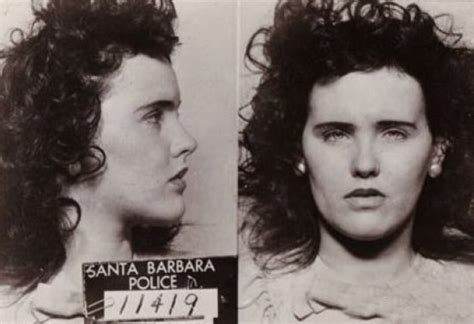The Black Dahlia case is one of the most infamous unsolved murder cases in American history, and the victim’s face has become an enduring symbol of the brutality and tragedy of the crime. Elizabeth Short, a 22-year-old woman from Massachusetts, was found brutally murdered in a vacant lot in Los Angeles on January 15, 1947. Her body had been mutilated, with evidence of severe torture and abuse.
One of the most striking aspects of the Black Dahlia case is the mutilation of Elizabeth Short’s face. According to the autopsy report, her face had been cut from the corners of her mouth to her ears, creating a grotesque, Joker-like smile. This gruesome injury has become one of the most enduring images of the case, and it has been the subject of much speculation and debate.
Despite the brutality of the crime, the Black Dahlia case remains a fascinating and complex puzzle. The investigation into Short’s murder was one of the largest and most extensive in Los Angeles history, with hundreds of suspects and tips pursued by the police. However, despite the efforts of the authorities, the case remains unsolved, and the identity of the killer remains a mystery.
In recent years, advances in forensic technology have led to new investigating techniques being applied to the case. In 2018, a former LAPD detective named Steve Hodel published a book in which he claimed that his father, George Hodel, was the killer. The book, which is based on the author’s own investigation, includes evidence from the crime scene and other sources that suggests George Hodel may have been responsible for the murder.
The Black Dahlia case has also been the subject of numerous books, films, and TV shows, including a 2006 film starring Josh Hartnett and Scarlett Johansson. The case continues to fascinate people to this day, and it remains one of the most infamous unsolved murders in American history.
Theories and Speculations
Over the years, numerous theories and speculations have emerged about the Black Dahlia case. Some believe that the killer was a doctor or someone with medical training, due to the precision and skill with which the mutilations were carried out. Others have suggested that the killer may have been a serial killer, and that the Black Dahlia case was just one of many murders they committed.
Despite the many theories and speculations, the true identity of the killer remains a mystery. The case continues to be the subject of much debate and discussion, with many people offering their own theories and opinions about what really happened.
The Impact of the Case
The Black Dahlia case has had a significant impact on popular culture, with numerous references to the case appearing in films, TV shows, and music. The case has also been the subject of numerous true crime books and documentaries, and it continues to fascinate people to this day.
The case has also had a significant impact on the way that police investigate murders. The Black Dahlia case was one of the first to use forensic evidence, such as fingerprints and blood analysis, to try to solve the crime. The case also highlighted the importance of preserving evidence and conducting thorough investigations.
Conclusion
The Black Dahlia case is a complex and fascinating puzzle that continues to captivate people to this day. The brutal mutilation of Elizabeth Short’s face is just one aspect of the case, and it has become an enduring symbol of the tragedy and brutality of the crime. Despite the many theories and speculations, the true identity of the killer remains a mystery, and the case continues to be the subject of much debate and discussion.
What was the significance of the Black Dahlia case?
+The Black Dahlia case was significant because of the brutality and mutilation of the victim's body, as well as the lack of progress in the investigation. The case became a sensation in the media and sparked a massive investigation, but the killer was never caught.
Who was the main suspect in the Black Dahlia case?
+There were several suspects in the Black Dahlia case, but none were ever proven to be the killer. One of the main suspects was Dr. George Hodel, a Los Angeles doctor who was investigated by the police in the 1950s. However, he was never charged with the crime.
What was the impact of the Black Dahlia case on popular culture?
+The Black Dahlia case has had a significant impact on popular culture, with numerous references to the case appearing in films, TV shows, and music. The case has also been the subject of numerous true crime books and documentaries, and it continues to fascinate people to this day.
In terms of the investigation, the Black Dahlia case was a landmark case in the use of forensic evidence. The police used fingerprints, blood analysis, and other forensic techniques to try to identify the killer, but they were ultimately unsuccessful. The case highlighted the importance of preserving evidence and conducting thorough investigations, and it led to significant changes in the way that police approach murder investigations.
The Black Dahlia case also had a significant impact on the public’s perception of crime and violence. The case was highly publicized, and it sparked a wave of fear and anxiety about crime in Los Angeles. The case also led to increased scrutiny of the police department and its handling of the investigation.
Overall, the Black Dahlia case is a complex and fascinating puzzle that continues to captivate people to this day. The brutal mutilation of Elizabeth Short’s face is just one aspect of the case, and it has become an enduring symbol of the tragedy and brutality of the crime. Despite the many theories and speculations, the true identity of the killer remains a mystery, and the case continues to be the subject of much debate and discussion.
The Black Dahlia case is a prime example of how a single crime can have a significant impact on popular culture and the public's perception of crime and violence. The case has been the subject of numerous books, films, and TV shows, and it continues to fascinate people to this day. The case also highlights the importance of preserving evidence and conducting thorough investigations, and it led to significant changes in the way that police approach murder investigations.
In conclusion, the Black Dahlia case is a complex and fascinating puzzle that continues to captivate people to this day. The brutal mutilation of Elizabeth Short’s face is just one aspect of the case, and it has become an enduring symbol of the tragedy and brutality of the crime. Despite the many theories and speculations, the true identity of the killer remains a mystery, and the case continues to be the subject of much debate and discussion.
The Black Dahlia case is a landmark case in the use of forensic evidence and highlights the importance of preserving evidence and conducting thorough investigations. The case has had a significant impact on popular culture and the public’s perception of crime and violence, and it continues to fascinate people to this day.


